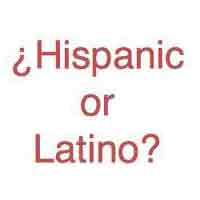Hispanic or Latino?

Hispanic? Latino? Or What?
By PHILIP B. CORBETT
The nomination of Sonia Sotomayor for the Supreme Court prompted discussion about our use of “Hispanic,” “Latino” and related terms. It’s not a simple issue, and I consulted with a number of reporters and editors here who offered good counsel.
Here are some key points to keep in mind:
• While both “Latino” and “Hispanic” are generally acceptable, some people have a strong preference. We should respect those preferences as much as possible in referring to individuals and groups; reporters and editors should routinely ask.
• Specific references like “Puerto Rican” or “Mexican-American” or “Guatemalan immigrant” are often best.
• Judge Sotomayor clearly uses “Latina” for herself, and we should respect that preference whenever feasible. In more detailed references, we can note that her parents moved to New York from Puerto Rico. Once again, remember: they were not immigrants.
• In describing one distinction she would attain if confirmed, I think we have to say she would be “the first Hispanic justice,” despite her own use of “Latina.” Calling her “the first Latina justice” isn’t quite what we mean, and several people I consulted agreed that calling her “the first Latino justice,” while perhaps grammatically defensible, seems awkward or wrong.
• I will adjust the current entry in The Times’s stylebook to clarify that “Latina,” like “Latino,” can be used as an adjective as well as a noun. We should be aware, though, that for many English speakers the use of inflected adjectives may still be unfamiliar.
• As always, references to ethnicity should be used only when they are pertinent, and the pertinence is clear to readers. One reporter pointed out that many second- and third-generation Latinos regard themselves as simply “American” or “Texan” or whatever. If ancestry is relevant, phrases like “a lawyer of Mexican descent” or “a New York native of Puerto Rican descent” might serve.
• Our stylebook defines “Hispanic” as “descended from a Spanish-speaking land or culture.” But be aware that opinions vary on how broadly to apply these terms. Can “Hispanic immigrants” describe a group that includes Brazilians or other Portuguese speakers? Can “Hispanic” describe immigrants from Spain itself? Once again, being specific will help minimize confusion or ambiguity.
• We should avoid constructions like “President Obama has nominated Judge Sotomayor to be the first Hispanic justice on the Supreme Court,” or “Judge Sotomayor is hoping to become the first Hispanic justice.” That phrasing suggests that their primary goal is to have a Hispanic justice. We can note the potential distinction parenthetically: “Judge Sotomayor, who would be the court’s first Hispanic justice, …” (Similarly, during the presidential campaign, we tried to avoid phrases like, “Senator Obama is campaigning to become the first African-American president” — that wasn’t the point of his campaign.)
A brief report from the Pew Hispanic Center offers some interesting background (including more on the Cardozo question). Here’s one section:
Q. How do Hispanics themselves feel about the labels “Hispanic” and “Latino”?
A. The labels are not universally embraced by the community that has been labeled. A 2006 survey by the Pew Hispanic Center found that 48% of Latino adults generally describe themselves by their country of origin first; 26% generally use the terms Latino or Hispanic first; and 24% generally call themselves American on first reference. As for a preference between “Hispanic” and “Latino”, a 2008 Center survey found that 36% of respondents prefer the term “Hispanic,” 21% prefer the term “Latino” and the rest have no preference.
Q. What about Puerto Ricans? Where do they fit in?
A. Puerto Ricans are U.S. citizens by birth — whether they were born in New York (like Judge Sotomayor) or in the Commonwealth of Puerto Rico (like her parents). According to the Census, some 97% of all persons born in Puerto Rico and living in the mainland United States consider themselves Hispanics. Overall, Puerto Ricans are the second largest group of Hispanics in the 50 states and District of Columbia — they make up 9% of the mainland Hispanic population, well behind the Mexican-origin share of 64%, but ahead of the 3.5% share of Cubans. In 2007, the 4.1 million persons of Puerto Rican origin living in the mainland United States exceeded Puerto Rico’s population of 3.9 million.
This article was retrieved from the New York Times article: http://afterdeadline.blogs.nytimes.com/2009/06/09/hispanic-latino-or-what/
